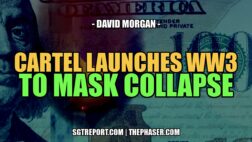Posted in reverse order– sorry, read the lower one first and then this one to put all thinking in proper perspective…
David Morgan Interviewed by Ellis Martin on The Opportunity Show
October 29, 2009, Part 2
Ellis Martin: Now let’s rejoin our conversation with the silver guru, David Morgan. So, essentially the Chinese are shunning the dollar in favor of their own yuan, as a methodology to boost the value of their own currency, to deal with the deflating dollar. And to continue to work toward controlling the market, not only are they doing that, but they also are buying all the resources around the world. They’re the major driving factor here, are they not, in addition to our own government just printing money?
David Morgan: I’d say China is definitely one of the main driving factors. Japan also has a great deal of debt. The dollar is in the carry trade mode right now, which means that the bank can make free money by borrowing dollars basically for zero and then renting them out at a specific interest rate. And if you can do that in a leverage environment, you can make quite a bit of money. So it’s a gift to the banking system.
But I want to go back to something I did a few years ago, Ellis, and that is a video on currency crisis. In fact, it’s on YouTube at http://www.youtube.com/watch?v=NN97tmw6qvY. This is something that I wrote about in The Morgan Report many years ago. It is from the movie Rollover, a movie that depicted basically the end of the U.S. dollar and a huge increase in the price of gold—thus a credit crisis, a currency crisis. And a credit crisis/currency crisis is in essence what we’re experiencing right now. Now the currency crisis part is arguable. Is it really happening? Is it going to take place as in the movie? I don’t think so, but Rollover makes some very, very important points, and at the conclusion of the movie, the Middle East (you might substitute the word China) has had it with the dollar and was going into the gold market very stealthily so as not to abruptly disturb the market. It wouldn’t move the price of gold up very far or very fast, but every month they’d go in and, instead of rolling over their bond position, they’d roll over something like 98% of it. And the 2% that they weren’t rolling over went back into cash and that cash went into the gold market and bought gold.
That’s how big positions are developed. You do it very slowly, over a lengthy span of time. You buy enough but not so much that it will actually move the market very much, and you build a position carefully and slowly. During this hypothetical situation in the Rollover film, the word got out that the Arabs were no longer favorable to the dollar and were buying gold. Once that hit the mainstream financial press it ensued a panic. Once the panic hits, you can’t turn it off. So then everybody was selling the dollar and everybody was moving into anything that they could that wasn’t a dollar, or primarily the gold market. The end of the movie shows a banker coming out of a Wall Street bank and throwing cash at the screaming crowd. Then the scene cuts to a news reporter who’s saying that what was witnessed outside the New York bank was happening all over the world, no currency was safe. The reporter names off all the currencies we’ve had, saying we’ve had a currency collapse.
Now I’m not predicting that, per se. But in reality, the U.S. dollar, by the Federal Reserve’s own admission, is worth about four pennies since the date the Fed was founded, so certainly it hasn’t fulfilled its mandate, which is to keep a strong currency.
How it’s all going to wind up I really don’t know, but I do think strongly that the U.S. dollar’s days as reserve currency of the world are limited. I do know through monetary history that probably the best place you can be is in the precious metals. That’s what history has shown us again and again and again. So that’s what I’m looking for. And I want to be careful here, because it’s the doom-and-gloom label I really don’t like. I think I’m more of a realist than a doom-and-gloomer.
There are many reasons for optimism, but when a system starts to unwind, you know it’s got to complete the cycle and this is something that’s happened before. It’s not something that’s unique in monetary history, but it’s unique to America, because we’ve never experienced it before. But if you review monetary history you’ll see there have been cycles and panics like this before.
People are survivors. They’re going to figure out how to best get through this, but the basis is that the overall living standard of the population of the United States, or North America actually, is probably going to be going down, generally speaking. It doesn’t mean the end. It doesn’t mean that it’s all over. It does mean that things are going to change.
Ellis: David, this is just some of the information that’s available on your Web site. We’ve just touched on the tip of the iceberg, so to speak, of what’s available on silver-investor.com. All about the currency crisis, all about the fact that the supply of gold and silver does not meet the demand now nor will it in the conceivable future, and of course your DVD entitled, “Silver Summit 2009.” Let’s talk about that.
David: Well certainly I’d be glad to talk a bit about the DVD. This was my keynote speech at the Silver Summit, which was in September 2009. It’s a speech that I developed based upon the real world and where we are financially in the United States, on a global basis. I compared that to the Weimar Republic. I didn’t really know until I undertook this study how comparable they were, and what I found was rather startling.
If you look at the money supply, the real wage rate, unemployment, and the stock market, and lined up all these things, if you could lay each graph on top of the other it would fit almost perfectly. So all these key components that I looked at lined up, with one slight but key difference at the end, and that is the M1 turnover rate. In other words, this is contrary to what I said a moment ago about how fast people want out of the dollar. The M1 turnover rate is below 1, which means that people do not want out of the dollar right now. The facts are what they are. Right now people are saving dollars. They’re not spending dollars. They’re scared to borrow. Or maybe they want to borrow but they’re not creditworthy, so they can’t borrow. . . . So there are a lot of factors right now that portend more deflationary pressures currently than inflationary pressure. And I go through this very carefully at the Silver Summit.
In addition to that keynote “big-picture” speech, I presented a summary of the key points in the silver market, and then a lunchtime speech about the psychology of the market, where we are on a psychological basis, and where I expect it to go in the future. Also on the DVD is the Webinar that we did with Hugo Salinas Price, advocating using silver currency in Mexico alongside the peso. Fascinating man, fascinating Webinar. And to round out the contents we included one more presentation, which has to do with the Weimar Republic and the destruction of the currency during the 1923 timeframe.
So it’s quite a summary of the Silver Summit that’s available on our Web site. If you’re a student of these markets, if you really want to be in the know, you might consider a purchase.
Ellis: Well I want to encourage everyone listening to this program right now to head over to your Web site, silver-investor.com, that’s silver-investor.com. If you don’t do it now, at least write down the name of that Web site because there’s enough information to assist a sophisticated investor and also to bring you up to speed if you’re a novice potential investor with regard to metals, resource stocks, whatever you like. Silver-investor.com. We’ve been speaking with the silver guru, David Morgan of The Morgan Report. Thank you, David, for joining us today on The Opportunity Show.
David: Always a pleasure, thank you.



